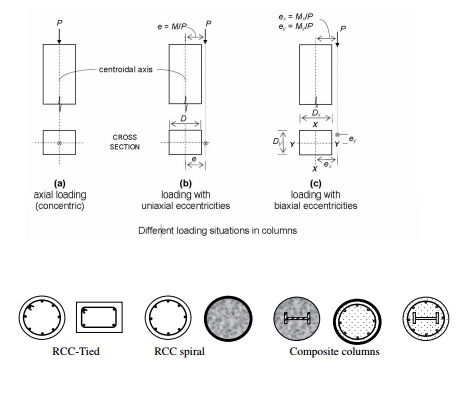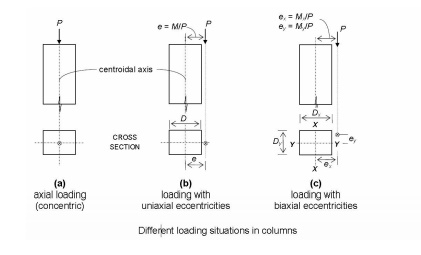Chapter: Civil : Design of Reinforced Concrete Elements : Limit State Design Of Columns
Classification of columns

A column is defined as a compression member, the effective
length of which exceeds three times the least lateral dimension. Compression
members, whose lengths do not exceed three times the least lateral dimension,
may be made of plain concrete. A column forms a very important component of a
structure. Columns support beams which in turn support walls and slabs. It
should be realized that the failure of a column results in the collapse of the
structure. The design of a column should therefore receive importance.
Introduction:
A column is a vertical structural member supporting axial
compressive loads, with or without moments. The cross-sectional dimensions of a
column are generally considerably less than its height. Columns support
vertical loads from the floors and roof and transmit these loads to the
foundations.
The more general terms compression members and members
subjected to combined axial load and bending are sometimes used to refer to
columns, walls, and members in concrete trusses or frames. These may be
vertical, inclined, or horizontal. A column is a special case of a compression
member that is vertical. Stability effects must be considered in the design of
compression members.
Classification
of columns
A column
may be classified based on different criteria such as:
1.Based
on shape
I.
Rectangle
II.
Square
III.
Circular
IV.
Polygon
V.
L type
VI.
T type
VII.
+ type

2.Based on slenderness ratio or
height
Short
column and Long column or Short and Slender Compression Members
A compression member may be considered as short when both the
slenderness ratios namely lex/D and ley/b are less than
12: Where
lex= effective length in respect of the major axis,
D= depth in respect of the major axis, ley= effective length in
respect of the minor axis, and b = width of the member.
It shall
otherwise be considered as a slender or long compression member.
The great majority of concrete columns are sufficiently stocky
(short) that slenderness can be ignored. Such columns are referred to as short
columns. Short column generally fails by crushing of concrete due to axial
force. If the moments induced by slenderness effects weaken a column
appreciably, it is referred to as a slender column or a long column. Long
columns generally fail by bending effect than due to axial effect. Long column
carry less load compared to long column.
3.Based on
pattern of lateral reinforcement
• Tied
columns with ties as laterals
• columns
with Spiral steel as laterals or spiral columns
Majority of columns in any buildings are tied columns. In a
tied column the longitudinal bars are tied together with smaller bars at
intervals up the column. Tied columns may be square, rectangular, L-shaped,
circular, or any other required shape. Occasionally, when high strength and/or
high ductility are required, the bars are placed in a circle, and the ties are
replaced by a bar bent into a helix or spiral. Such a column, called a spiral
column. Spiral columns are generally circular, although square or polygonal
shapes are sometimes used. The spiral acts to restrain the lateral expansion of
the column core under high axial loads and, in doing so, delays the failure of
the core, making the column more ductile. Spiral columns are used more
extensively in seismic regions. If properly designed, spiral column carry 5%
extra load at failure compared to similar tied column.
4.Based on
type of loading
• Axially
loaded column or centrally or concentrically loaded column (Pu)
• A column
subjected to axial load and unaxial bending (Pu + Mux) or
(P + Muy)
A column
subjected to axial load and biaxial bending (Pu + Mux + Muy)

5. Based on materials
Timber,
stone, masonry, RCC, PSC, Steel, aluminium , composite column

Related Topics